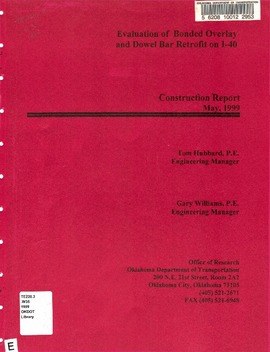| dc.description.abstract | The Oklahoma Department of Transportation (OOOT) has completed a rehabilitation project on a 1,000 foot-long section of existing jointed PCC pavement. ThC section is located in the westbound traffic lanes of 1-40, in Canadian County. As jointed PCC pavements age, many develop faults, resulting in poor ride quality (roughness). Faults can be removed, and ride quality restored, by grinding, but this often proves to be only a short-term solution. Longer lasting solutions generally require addressing sttuctural factors, such as void formation in the subgrade and lack of load transfer between slabs. Another cmunon problem associated with aging pavements is loss of smface friction characteristics. Smface friction may be restored by grinding or by placing an overlay. Traditional methods of improving load transfer between slabs generally require saw cutting a section of each slab, removing it, drilling holes into the acljacmt slab and fastening dowel bars into the holes with epoxy. The joint then has to re-formed, and new concrete poured to replace the removed section. These methods are labor-intensive and expensive. Wen ckmc m the rehabilitated scctim consisted of :rmofitting Load Transfer Units (dowel bars with expansion caps} between the slabs, and placing a thin, bonded, fiber-reinforced PCC ov~lay. The n:babilitation done on this project has the potential of restoring ride quality, improving load transfer between slabs, and improving smface friction characteristics using a faster, less labor-intensive process. ODOT has not used this method in the past. The ccmstruction operaticms will be evaluated mm a constructabilit standpoint. The completed overlay will be evaluated with the goal of projecting the long-term performance of the rehabilitated section. | |
